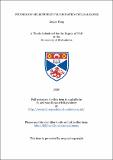Studies on selectively fluorinated cycloalkanes
Abstract
The thesis focuses on the synthesis of novel fluorinated cycloalkanes and their polar properties.
Chapter 2 describes the synthesis of all cis-1,2,3,4-tetrafluorocyclopentane and its deuterated isotopomer. They were prepared from the dicyclopentadiene. The structure of cis-1,2,3,4-tetrafluorocyclopentane was characterised by NMR and X-ray crystallography. This structure proved to have high polarity and a calculated dipole moment is 4.9 Debye. The deuterated isotopomer was also characterised by NMR and it indicated that this molecule has highly polarized faces similar to all cis-1,2,3,4-tetrafluorocyclopentane. The polarity of the isotopomers were compared by GC-MS analysis and this gave an indication that per-deuterated isotopomer is more polar than the all cis-1,2,3,4-tetrafluorocyclopentane.
Chapter 3 describes the synthesis of a series of fluorinated cyclopropanes, with a particular focus on the preparation of the all cis-1,2,3-trifluorocyclopropane motif. The synthesis started from the fluorinated styrene, followed by bromofluocarbene (:CFBr) addition and reductive debromination. This provided the first synthetic access to this motif. The lipophilicity (Log P) of a series of fluorinated cyclopropanes was investigated and the results demonstrated that the all cis-1,2,3-trifluorocyclopropane was the most polar compound among this series.
Chapter 4 describes unexpected results from the fluorination of benzo[a,e]cyclooctatetraene with NBS, HF·Py and AgF(I), which was anticipated to generate all-cis-5,6,11,12-tetrafluoro-5,6,11,12-tetrahydrodibenzo[a,e]cyclooctane. However, the reaction gave a mixture of products and the product outcomes strongly suggests that an extensive carbocation/phenonium rearrangements pathway occurred during the reaction. The origin of oxygen in the final ether products was shown by an 18O isotope labelling experiment with water and the result suggests a {Ag}O- species is the most likely oxygen provider.
Chapter 5 describes the synthesis of a series of novel liquid crystals with fluorinated cyclopropane motifs at their terminus. The synthesis proved straightforward such that these novel liquid crystal candidates can be prepared on scale. Their thermodynamic and physical properties, such as birefringence (Δn), dielectric anisotropy (Δε) and rotational viscosity (ϒ) were analysed by Merck & Co. Although none of the liquid crystal candidates met all the criteria for Liquid Crystal Display (LCD) development, the study gives an insight into the potential for fluorinated cyclopropane motifs in liquid crystals.
Type
Thesis, PhD Doctor of Philosophy
Collections
Items in the St Andrews Research Repository are protected by copyright, with all rights reserved, unless otherwise indicated.

